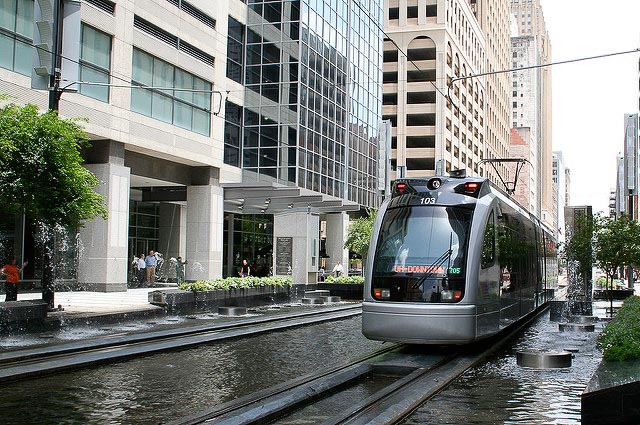 Image via flickr/Ed Schipul.
Image via flickr/Ed Schipul.A new report from researchers at the George Washington University School of Business highlights what, anecdotally, many cities are already experiencing: automobile-focused suburbanism that dominated the late 20th century seems to be reversing, as walkable development in central cities and suburban downtowns enjoys a rise in market share.
In all of the 30 cities the researchers surveyed, walkable office and multi-family rental space gained ground, “probably for the first time in over 60 years,” they wrote.
Houston & Dallas
The researchers, Christopher Leinberger and Michael Rodriguez, called out Houston and Dallas particularly in the report. They remarked that the two Texas cities are generally "the great exception to the walkable urban trend" but also noted that "things are changing" in Texas. They write of the two cities:
Given their histories as oil- and gas-based metro economies, their moderate-to-low walkable urbanism rankings for both current and development momentum are fitting. The recent influx of major corporate headquarter locations and high-tech firms have helped Houston and Dallas generate the sixth- and seventh-highest real GDP per capita of the largest 30 metros in the country.
But as sprawling, car-based metros with top-ten levels of GDP per capita, Houston and Dallas should be considered exceptions that prove the rule. The oil and gas industries provide a unique foundation to their economies that will not be replicated in other metros. Yet, both metros are ... indicating strong walkable urban market share capture, and significant rental rate premiums. Additionally, metro Dallas has been building one of the largest new light rail systems in the country, second only to metro Los Angeles — a solid effort toward future walkable urban development.
Rankings
The report focuses on what is calls “WalkUPs,” or walkable urban places, of which are are 619 in the country’s 30 largest metro areas. Researchers based their definition of a WalkUP as a place with a certain threshold of office or retail square footage, a high walk score, and great intersection density.
Houston, according to the report, has 16 WalkUPs. That's vastly fewer than places like New York (67), San Francisco (56) and Boston (54) but considerably more than metros like Tampa (6), San Antonio (2) and Phoenix (4).
Overall, the report ranks the Houston metro area 20 for “walkable urbanism,” calculated as the share of occupied office, retail, and multi-family rental space within its WalkUPs. Article continues below chart.
 Image via GWU School of Business.
Image via GWU School of Business.Reversing sprawl
Cities that already had strong walkability showed some of the greatest gains from 2010 to 2015, but the trend was especially significant in places like Houston, Miami and Los Angeles as well. Described in the report as having “low-middle walkable urbanism,” those three cities “are nearly synonymous with drivable sub-urbanism.” Yet even in those places, the environment is shifting. “It is no coincidence that these three metros have made substantial investments in rail transit over the past decade,” Leinberger and Rodriguez write.
Suburban walkability
And the changes aren't just happening in the traditional city center. “Focusing predominantly on the redevelopment of the central city misses segments of the market that want walkable urbanism outside it and generally closer to suburban households and businesses,” the researchers write.
Many places have successfully created walkable suburban centers. Here, Houston does particularly well, ranking third.
But there’s still interest in more such development. Nearly half – 43 percent – of Fort Bend County residents said they want to live in a more urban, walkable community, according the 2016 Kinder Houston Area Survey. At the same time, 65 percent of those suburban residents interested in walkability don’t actually live in a walkable area.
Rising rent and equity
The report sheds light on another trend that's coincided with the rise of walkable urbanism – rising rent premiums. “All 30 metros had positive average rent premiums for walkable urban real estate products,” according to the study, which compared rents for walkable urban products, like office and multi-family rental units, to drivable suburban ones. Houston fell in the middle of the pack, ranking 15th of 30, with a 48 percent difference between its urban real estate values and suburban ones in the final quarter of 2015.
But there are benefits to walkable urbanism that seem to offset some of the increasing rental premiums.
For one, the report linked walkability, higher GDP per capita and higher educational attainment levels, likely supporting author Richard Florida’s theory that walkable places are attractive to the “creative class.” Houston was a bit of an exception. Though it ranked in the lower third for walkability, it had one of the highest GDP per capita, which bucks the idea of a direct link between walkability and economic activity. The report attributes Houston as an outlier that has benefited uniquely from the oil and gas industry.
Outlook
Whether the trend of walkability continues depends in large part on the middle- and lower-ranked metro areas like Houston, according to the study.
“With their histories of drivable sub-urban development, and reliance on automobiles and trucks, metros with low walkable urbanism generally resist walkable urban development,” the authors write.
“These metros, however, display indications of movement towards walkable urbanism based on the data in this analysis and because of local support for walkable urbanism, including developers, neighborhood activists, and elected leaders. Nonetheless, dominant infrastructure, zoning, and land-use subsidies for many metros will continue to favor drivable sub-urban development in lower-ranked metros.”
What's the outlook for walkability Houston? Unfortunately, not as good as that of most other big metros, according to the report. Houston ranked behind Los Angeles and Miami in the report's ranking of walkable development "momentum," at 20th of the 30 metros in the study.

